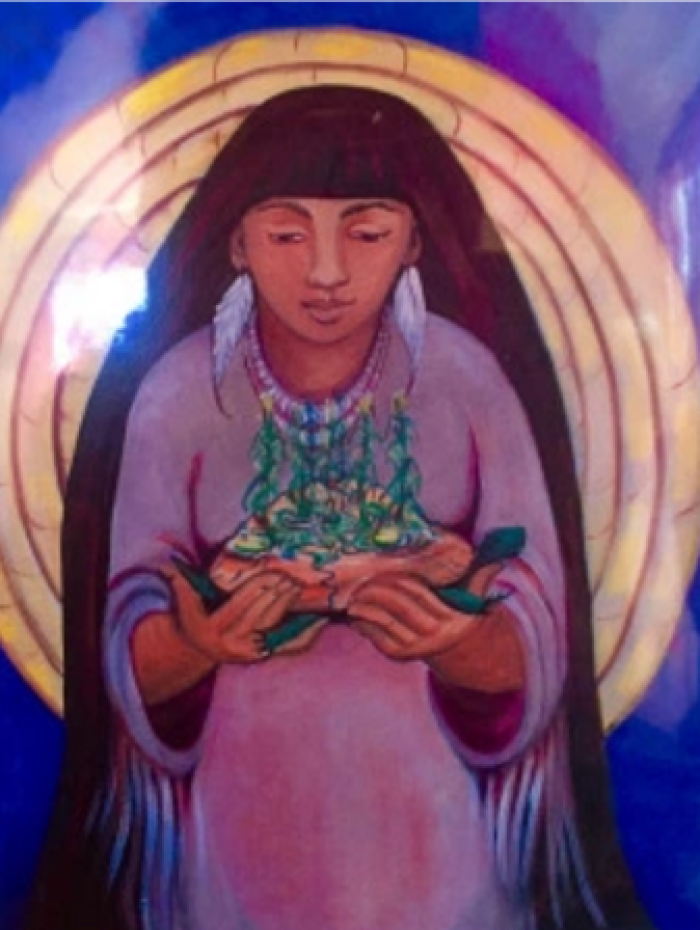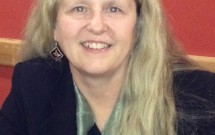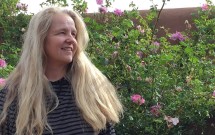
Bringing the Divine Feminine to Campus by Ann Filemyr, Ph.D.
I believe the Ultimate could be a vast energetic being, nameless, formless, skinless, disembodied raw creative force power zipping through the universe in the never-ending processes of making and unmaking, being, becoming and dissolving back into non-being. The Great Mystery, who I refer to in the Anishinaabe as Gitchi Manitou, is beyond comprehension, yet we are all part of the Mystery, and this Mysterious-Creative-Spark is part of everyone and everything. The Taoist text, Tao Te Ching, states, “The one you can name is not the Eternal One.” It makes sense to me that the Ultimate-Being lies beyond what can be known or named.
Still we are small beings in this vast universe. We are embodied and gendered and racialized and categorized in particular ways by our societies. These little boxes that our immensity is supposed to fit inside are limiting by their very natures. Yet we are raised to identify with the labels assigned to us. They become real in this sense, and these defining categories influence us and shape our relationships.
Not the least of these relationships is our relationship with the divine (however we define the Divine). What do we believe in that is more abiding, more pervasive, greater in every sense than the laws and policies governing human social and political life? What is this Great Law? How do we relate to the Abiding Truth? Who do we worship? How do we establish this relationship?
These are great questions, and Southwestern College where I now teach and learn urges students to explore and find the answers for themselves.
That said, it still matters to me that this Creative-Force-Power when represented at all is represented in all possible genders. Not just masculine or male. I have spent decades seeking and finding divine representatives that are female, gender fluid and beautiful. I want at least half of the images of divinity that surround me at work or home to be breasted, vulvic, wombish women. Of course, I am looking for myself among the images of the Divine.
Why does it matter? Gender oppression persists today. Religions built on the exclusion and suppression of the divine feminine persist. Religious organizations that exclude women from leadership persist. The invisibility of the sacred expressed in a female form is a reality. Yet half of the population is female.
So when I arrived as the new Vice President of Academic Affairs & Dean at Southwestern College in the summer of 2014, I noticed a void of images representing the Almighty Omnipotent Omnipresent One in a feminine form. The student center has a room dedicated to spirituality. It is called the Spiritual Practice Room. I entered the draped, comfortable quiet respectfully. There I found images and statues of the Buddha, Jesus Christ, various male gurus like Swami Vivikinanda and Paramahansa Yogananda, a large woven God’s Eye, photos of male spiritual teachers: Gurdjieff, Krishnamurti, the Dalai Lama. A statue of the Hindu elephant god, Ganesh. On the narrow shelf was an I Ching and a Bible. But where were the female spiritual leaders? Where were the feminine divinities?
There She was! Goddess of Santa Fe, reigning Holy Mother: Guadalupe in all of her shining glory. She stood tall, a large image on the top shelf with a candle dedicated to her. Guadalupe appeared to the Indian peasant, Don Diego, in her glowing divine form on the site of the demolished temple to the Mother Goddess of the Aztecs, Tonantzin. She is a bridge between the Old Ways of the Americas and the culture of the Spanish colonizer. She made a way for brown-skinned people to see a Brown Madonna on the altar at the front of the cathedral. She resides over our city from her perch on Guadalupe Street. Every December 11 there is an evening candlelight procession in her honor and the following day, December 12, is dedicated to her. It made me happy to see her, and I left the Spiritual Practice Room satisfied though not entirely content.
In the fall of 2015, a few students brought their concern about the lack of images of female divinity on campus to my attention. (Thanks, Connor!) Like any good educator, I know students come first. All I needed was this prompt, and I leapt into action.
I invited them to bring any images or books to add to the room. Then I took the initiative upon myself and began populating the room with new female faces and feminine forms to represent this aspect of the Vast-Unnamable-Energetic-Quest-of-the-Living-Cosmos-to-Know-Itself.
Earlier today I added a small statue representing the sacred oracle of Malta, the female prophet, seer and Goddess incarnate. I placed a few mermaid images here and there to present Mami Wati and Yemonj/Yemaya. I added a carved wooden fertility figure with cowrie shells I brought back from Senegal. From the covers of the We’Moon calendar, I added paintings of strong powerful female beings. I placed an image of a Corn Mother on the front altar to honor our location here on ancestral Pueblo land. I added a lovely brown Madonna. I donated a stack of my old Woman Power magazines, and a copy of The Womyn’s Book of Runes that I wrote twenty years ago after studying the Celtic runes.
It’s not enough. The room still is not fifty/fifty when it comes to gender representation. It needs some Afrocentric Goddesses, Oshun would be nice. I would love to see Oya here. She is associated with the Haitian Maman Brigette who is syncretized with the Irish St. Brigit. These powerful birth-death-solar-storm-wind-bright-burning-female-divinities are close to my firey heart. Obatallah would be terrific, too, as s/he is a gender fluid god from the Orisha tradition of West Africa imported to the Americas in the bellies of slave ships and celebrated now in Cuba, Haiti, Brazil and the U.S.
We are still missing so many: Artemis, Aphrodite, Dobeiba, Hathor, Isis, Grandmother Moon, Blue Flame Woman, Kali, Ixchel and so many more. What about Jigonhsasee? Today I noticed Guru Mai is there and so is St. Therese. Change is happening in our campus Spiritual Practice Room. Sometimes it just takes a first step.
 Southwestern College Santa Fe, NM
Southwestern College Santa Fe, NM





